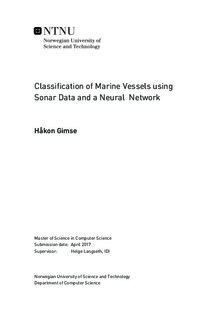Classification of Marine Vessels using Sonar Data and a Neural Network
Master thesis
Permanent lenke
http://hdl.handle.net/11250/2453247Utgivelsesdato
2017Metadata
Vis full innførselSamlinger
Sammendrag
A submarine navigator have to keep track of surrounding ships in order to avoid collision and to gain a tactical advantage. This is currently done manually by a sonar operator, trained to listen through the water and identify ship-types by the sound they emit.
This project presents a review and implementation of different solutions to the problem of audio classification. The goal of this work was to build a system capable of helping submarine navigators identify surrounding obstacles and ships based on the sound recorded by the sonar on board the submerged submarine.
The research aims to uncover the best combination of techniques that can be used for this classification task. This project concerns both the field of signal analysis and artificial intelligence as the system comprises of two parts. The first being a method of extracting informative features from sonar data captured by the submarine. The second part is to feed the processed data into a neural network (NN) and provide a classification of the ship's type.
In this project a system have been developed in order to experiment with a variety of feature extraction techniques and neural network structures to find a solution suitable for the submarine sonar classification problem. The system have been able to place 97.3\% of the ships in the correct category when using the highest scoring combination of a feature extraction technique and a neural network. The best found combination was the Mel Frequency Cepstral Coefficients feature extraction technique and a standard feed-forward neural network.
